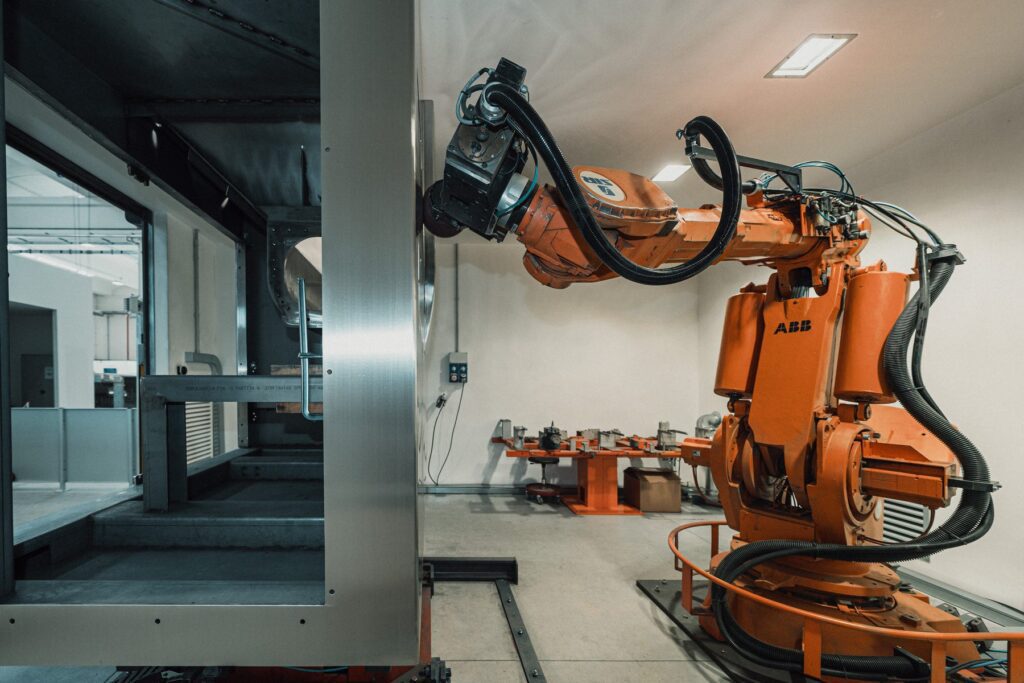Steel brushing is a very popular finish for semi-finished products and complex assemblies. It is performed after other processes (such as bending and welding) to eliminate inaccuracies and to make the stainless steel more homogenous, smooth to the touch and opaque.
Its function is aesthetic, but also hygienic: brushing makes the surface easier to clean and suitable for use in the food and medical sectors.
In this article, we will describe how the brushing process takes place, its advantages and the effect on the appearance of the final product.
Features and benefits of steel brushing
Brushing is a precision operation that eliminates irregularities on stainless steel surfaces.
It is generally carried out in the last stages of the production process to remove small defects or “smooth” the metal, giving it a matt and less shiny appearance.
In particular, it is useful to:
- make the surface smooth and homogenous, eliminating irregularities;
- cover metal surface defects;
- eliminate shiny effects.
Usually, it is performed using specific tools and machinery – manual or automated – that, thanks to the combination of abrasive brushes with variable grain size and wax-like substances, enable stainless steel to be worked to eliminate superficial defects in the metal or residues from previous processes.
To be carried out to perfection, brushing must be light. Abrasive brushes, in fact, must act gently on the metal to structure the surface, without removing or damaging its layers.
A very precise operation that is usually carried out with state-of-the-art equipment. In particular, when they are robotised, they are “instructed” and configured with the right specifications by skilled workers to complete the assembly or semi-finished product with the finish agreed with the customer.
The equipment plays an important role in this phase, as does the degree of preparation of the workers specialized in the stainless steel processing.
For this reason, Metal’s fleet will soon be expanded with new equipment and, at the same time, we will invest in employees training. In particular, we will have 9 brushing booths, 6 of which are manual systems and 3 robotic systems, to speed up the production process and guarantee the finishing of semi-finished products and complex assemblies within the agreed times.
Does brushing increase steel strength?
Stainless steel boasts several properties including deformability, hardness, ease of cleaning, thermal conductivity and resistance to corrosion. Choosing brushing as a finish not only increases the metal’s strength but also offers other interesting advantages.
This particular finish, in fact, is useful for other purposes. As we have already mentioned, on an aesthetic level it eliminates imperfections, even those that may occur during machining. At Metal’s, for example, we choose the raw material in accordance with our customers’ needs both in terms of aesthetic requirements and technical specifications.
However, during the production process, small porosities and micro-cracks can be created in the material, especially during welding, laser cutting or punching phases. In this case, brushing the steel allows not only to eliminate residues of previous processing (such as dark spots accumulated during welding, for example) but also to level the metal, making it smooth to touch again and without imperfections.
Futhermore, this finishing is required by companies operating in the medical and food industries because it is able to remove all pores from stainless steel, guaranteeing greater hygienic safety. Micro-cracks can harbour bacteria, which are not particularly welcome in these areas, which must be aseptic and easy to clean.
Stainless steel, in fact, is the only material suitable for coming into contact with food. Moreover, thanks to its high resistance to corrosion and extreme temperatures, it is one of the most widely used materials in the medical sector.
In order to maintain these valuable characteristics, however, stainless steel must always be perfect. Brushing, therefore, is an important finish because it can ensure a low roughness to the metal (about 0.8 microns), smoothen the surface and prevent contamination.

Where should brushing be used?
To summarise, brushing can be applied in all areas and on all products, but it is especially recommended in the food and medical fields to produce semi-finished products and complex stainless steel assemblies that are safe, easy to sanitise and without the risk of contamination.
On an aesthetic level, for example, it can be useful to eliminate any imperfections from the surfaces of semi-finished products and components that require high aesthetic characteristics such as for professional kitchens, machines, for bakery or professional cafeterias.
The finishing can also be applied to switchboards, control cabinets and other specific equipment for industrial use.
Finally, it can be used for the finishing refrigerators, food processing machines, meat processing machines, bottling machines and other appliances for the catering or large-scale distribution, ensuring product durability and easy maintenance.
Brushed steel maintenance and cleaning
Cleaning, sanitizing and maintaining brushed steel is very simple and fast.
In order not to damage the material, while preserving aesthetics and resistance over time, it is advisable to use a soft cloth and specific detergents for stainless steel, especially when the finished products are used in the HORECA, medical or industrial sector. Even ethyl alcohol, to be sprayed on the surface and immediately removed with a dry cloth, also guarantees cleanliness and shine.
In addition, you should not use:
- abrasive sponges and metal sponges, which can cause surface scratches;
- bleach and chlorine-based detergents, which reduce the resistance of steel.
By following these steps, steel will retain its characteristics for a long time and will not be damaged.
Do you want to know more?
What are the benefits of brushing? Trust Metal’s, find out what this finish consists of and what benefits it could bring to your project.

